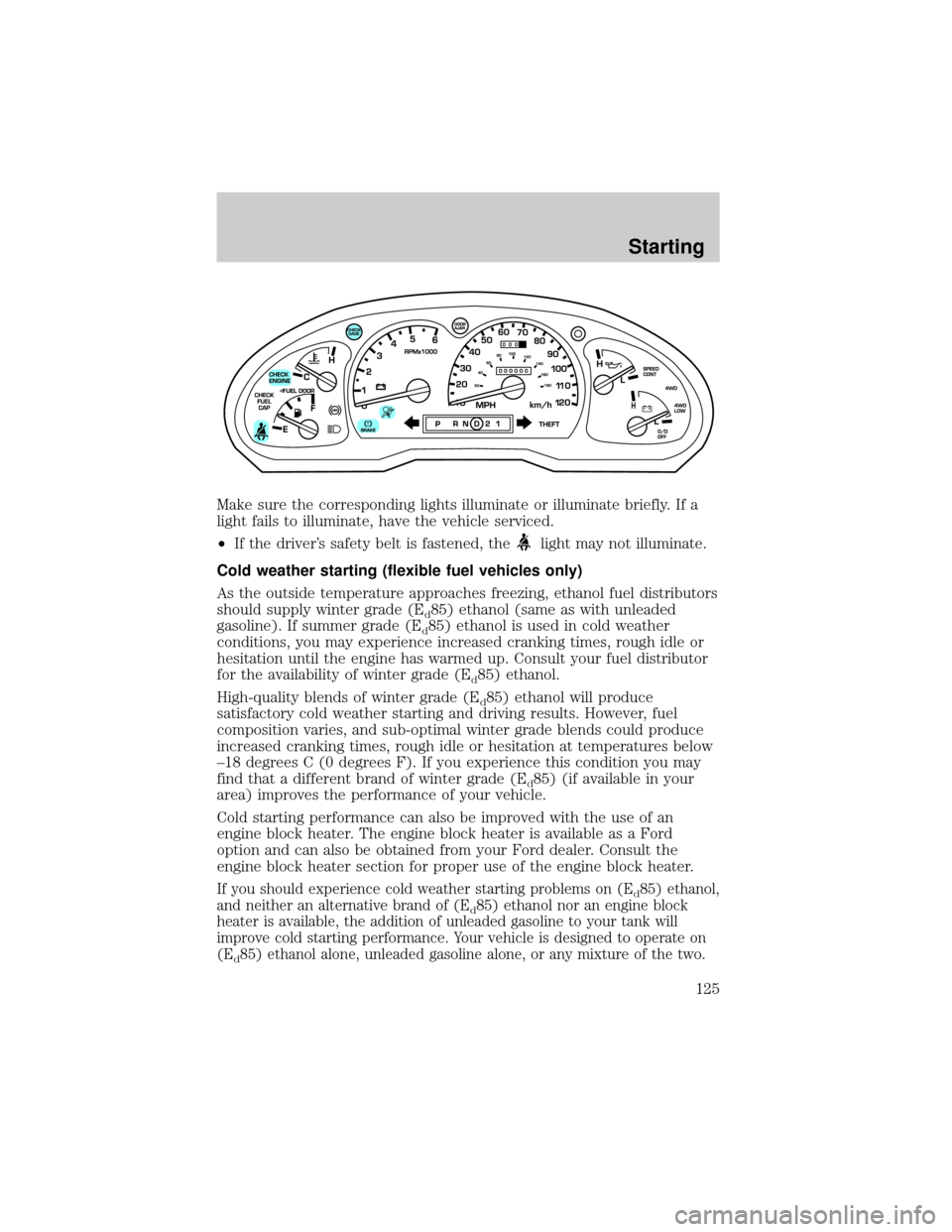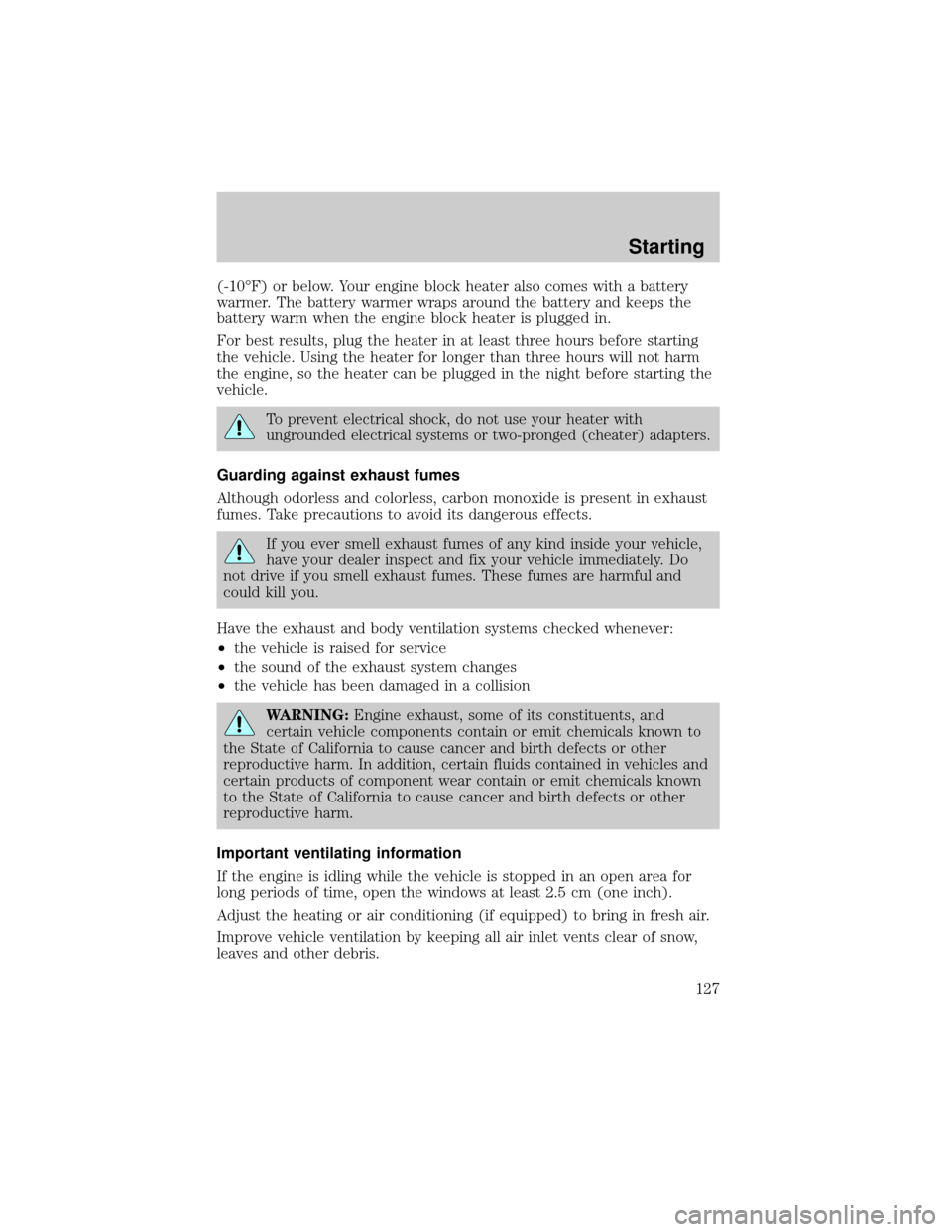2001 FORD RANGER heater
[x] Cancel search: heaterPage 22 of 272

CLIMATE CONTROL SYSTEM
Heater only system (if equipped)
Fan speed control
Controls the volume of air circulated
in the vehicle.
Temperature control knob
Controls the temperature of the
airflow inside the vehicle. On
heater-only systems, the air cannot
be cooled below the outside
temperature.
Mode selector control
Controls the direction of the airflow
to the inside of the vehicle.
²
(Panel)-Distributes outside air through the instrument panel
registers.
²
(Panel and floor)-Distributes outside air through the instrument
panel registers and the floor ducts.
²OFF-Outside air is shut out and the fan will not operate. For short
periods of time only, use this mode to prevent undesirable odors from
entering the vehicle.
²
(Floor)-Allows for maximum heating. Distributes outside air
through the floor ducts.
²
(Floor and defrost)-Distributes outside air through the floor ducts
and the windshield defroster ducts.
²
(Defrost)-Distributes outside air through the windshield defroster
ducts. It can be used to clear ice or fog from the windshield.
OFF
OFF
Controls and features
22
Page 125 of 272

Make sure the corresponding lights illuminate or illuminate briefly. If a
light fails to illuminate, have the vehicle serviced.
²If the driver's safety belt is fastened, the
light may not illuminate.
Cold weather starting (flexible fuel vehicles only)
As the outside temperature approaches freezing, ethanol fuel distributors
should supply winter grade (E
d85) ethanol (same as with unleaded
gasoline). If summer grade (E
d85) ethanol is used in cold weather
conditions, you may experience increased cranking times, rough idle or
hesitation until the engine has warmed up. Consult your fuel distributor
for the availability of winter grade (E
d85) ethanol.
High-quality blends of winter grade (E
d85) ethanol will produce
satisfactory cold weather starting and driving results. However, fuel
composition varies, and sub-optimal winter grade blends could produce
increased cranking times, rough idle or hesitation at temperatures below
±18 degrees C (0 degrees F). If you experience this condition you may
find that a different brand of winter grade (E
d85) (if available in your
area) improves the performance of your vehicle.
Cold starting performance can also be improved with the use of an
engine block heater. The engine block heater is available as a Ford
option and can also be obtained from your Ford dealer. Consult the
engine block heater section for proper use of the engine block heater.
If you should experience cold weather starting problems on (Ed85) ethanol,
and neither an alternative brand of (E
d85) ethanol nor an engine block
heater is available, the addition of unleaded gasoline to your tank will
improve cold starting performance. Your vehicle is designed to operate on
(E
d85) ethanol alone, unleaded gasoline alone, or any mixture of the two.
Starting
125
Page 126 of 272

If the engine fails to start using the preceding instructions
1. Press the accelerator pedal 1/3 to 1/2 of the way to floor and hold.
2. Turn the key to START position.
3. When the engine starts, release the key, then release the accelerator
pedal gradually as the engine speeds up.
4. If the engine still fails to start, repeat steps one through three.
5. After the engine starts, hold your foot on the brake pedal, put the
gearshift lever in gear and release the parking brake. Slowly release the
brake pedal and drive away in a normal manner.
STARTING THE ENGINE
NOTE:Whenever you start your vehicle, release the key as soon as the
engine starts. Excessive cranking could damage the starter.
1. Turn the key to 5 (START)
without pressing the accelerator
pedal and release as soon as the
engine starts. The key will return to
4 (ON).
2. If the temperature is above ±12ÉC
(10ÉF) and the engine does not
start within five seconds on the first
try, turn the key to OFF, wait 10
seconds and try again.
3.
If the temperature is below -12É C (10É F) and the engine does not
start in 15 seconds on the first try, turn the key OFF and wait 10 seconds
and try again. If the engine does not start in two attempts, press the
accelerator pedal all the way to floor and hold. Turn the key to START
position.
4. When the engine starts, release the key, then release the accelerator
pedal gradually as the engine speeds up.
5. After idling for a few seconds, apply the brake and release the parking
brake.
Using the engine block heater (if equipped)
An engine block heater warms the engine coolant, which improves
starting, warms up the engine faster and allows the heater-defroster
system to respond quickly. Use of an engine block heater is strongly
recommended if you live in a region where temperatures reach -23ÉC
3
2
1
5
4
Starting
126
Page 127 of 272

(-10ÉF) or below. Your engine block heater also comes with a battery
warmer. The battery warmer wraps around the battery and keeps the
battery warm when the engine block heater is plugged in.
For best results, plug the heater in at least three hours before starting
the vehicle. Using the heater for longer than three hours will not harm
the engine, so the heater can be plugged in the night before starting the
vehicle.
To prevent electrical shock, do not use your heater with
ungrounded electrical systems or two-pronged (cheater) adapters.
Guarding against exhaust fumes
Although odorless and colorless, carbon monoxide is present in exhaust
fumes. Take precautions to avoid its dangerous effects.
If you ever smell exhaust fumes of any kind inside your vehicle,
have your dealer inspect and fix your vehicle immediately. Do
not drive if you smell exhaust fumes. These fumes are harmful and
could kill you.
Have the exhaust and body ventilation systems checked whenever:
²the vehicle is raised for service
²the sound of the exhaust system changes
²the vehicle has been damaged in a collision
WARNING:Engine exhaust, some of its constituents, and
certain vehicle components contain or emit chemicals known to
the State of California to cause cancer and birth defects or other
reproductive harm. In addition, certain fluids contained in vehicles and
certain products of component wear contain or emit chemicals known
to the State of California to cause cancer and birth defects or other
reproductive harm.
Important ventilating information
If the engine is idling while the vehicle is stopped in an open area for
long periods of time, open the windows at least 2.5 cm (one inch).
Adjust the heating or air conditioning (if equipped) to bring in fresh air.
Improve vehicle ventilation by keeping all air inlet vents clear of snow,
leaves and other debris.
Starting
127
Page 179 of 272

4. Check all battery terminals and remove any excessive corrosion before
you attach the battery cables. Ensure that vent caps are tight and level.
5. Turn the heater fan on in both vehicles to protect any electrical
surges. Turn all other accessories off.
Connecting the jumper cables
1. Connect the positive (+) booster cable to the positive (+) terminal of
the discharged battery.
Note:In the illustrations,lightning boltsare used to designate the
assisting (boosting) battery.
2. Connect the other end of the positive (+) cable to the positive (+)
terminal of the assisting battery.
+–+–
+–+–
Roadside emergencies
179
Page 258 of 272

Comfort and convenience
Air conditioning
Battery warmer
Cargo organizers
Cargo retention net
Cargo shades (Super Cab 2 door)
Engine block heaters
Manual sliding rear window
Tire step
Underbody lighting
Travel equipment
Automatic headlamp system with DRL
Bed extender
Bed rail caps
Bed tent (Short bed, Styleside only)
Cellular phone holder
Compass mirror
Compass mirror with outside temperature reading
Daytime running lights
First aid kit
Fog lights
Heavy-duty battery
Peace of mind kit
Pickup box rails (tubular)
Removable bike carrier (bed mount/hitch mount)
Running boards/bars
Speed control
Trailer hitch (Class III)
Trailer hitch bars and balls
Trailer hitch wiring adaptor
Customer assistance
258
Page 265 of 272

lubrication specifications ......243,
245
refill capacities ........................240
service points ..................186±188
starting after a collision .........159
Engine block heater .................126
Engine oil ..................................189
checking and adding ..............189
dipstick ....................................189
filter, specifications ........193, 240
recommendations ...................193
refill capacities ........................240
specifications ..................243, 245
Exhaust fumes ..........................127
F
Flexible Fuel Vehicle (FFV) ....215
Fluid capacities .........................240
Foglamps .....................................20
Four-Wheel Drive
vehicles ................................14, 138
control trac ...............................27
description ..............................139
driving off road .......................141
electronic shift ..................27, 139
indicator light .........................139
preparing to drive your
vehicle .....................................131
Fuel ............................................215
calculating fuel economy .......222
cap .....................................11, 218
capacity ...................................240
choosing the right fuel ...........219
comparisons with EPA fuel
economy estimates .................225
detergent in fuel .....................221
filling your vehicle
with fuel ..................215, 218, 222filter, specifications ........221, 240
fuel pump shut-off switch .....159
gauge .........................................16
improving fuel economy ........222
octane rating ...........219, 245±246
quality ......................................220
running out of fuel .................221
safety information relating to
automotive fuels .....................215
Fuses ..................................161±162
G
Gas cap (see Fuel cap) ......11, 218
Gas mileage (see Fuel
economy) ...................................222
Gauges .........................................16
battery voltage gauge ...............19
engine coolant temperature
gauge .........................................17
engine oil pressure gauge ........19
fuel gauge ..................................16
odometer ...................................18
speedometer .............................18
tachometer ................................17
trip odometer ............................18
GAWR (Gross Axle Weight
Rating) .......................................144
calculating ...............................146
definition .................................144
driving with a heavy load ......144
location ....................................144
GVWR (Gross Vehicle Weight
Rating) .......................................144
calculating .......................144, 146
definition .................................144
driving with a heavy load ......144
location ....................................144
Index
265
Page 266 of 272

H
Hazard flashers .........................159
Headlamps ...................................20
aiming ......................................233
bulb specifications ..................232
daytime running lights .............20
flash to pass ..............................21
high beam ...........................13, 21
replacing bulbs .......................227
turning on and off ....................20
warning chime ..........................15
Heating ........................................22
heater only system ...................22
Hood ..........................................185
I
Ignition .........................65, 245±246
Infant seats
(see Safety seats) .....................114
Inspection/maintenance (I/M)
testing ........................................226
Instrument panel
cleaning ...................................238
cluster ................................10, 238
lighting up panel and
interior .......................................21
location of components ............10
J
Jack ............................................171
positioning .......................171, 175
storage .....................171±173, 175
Jump-starting your vehicle ......178K
Keys .......................................85±87
key in ignition chime ...............15
positions of the ignition ...........65
L
Lamps
bulb replacement
specifications chart ................232
cargo lamps ...............................21
daytime running light ...............20
fog lamps ...................................20
headlamps .................................20
headlamps, flash to pass ..........21
instrument panel, dimming .....21
interior lamps ...................71, 233
replacing bulbs .......227, 229±232
Lane change indicator (see
Turn signal) .................................64
Lights, warning and indicator ....10
air bag ........................................12
anti-lock brakes (ABS) ....13, 129
anti-theft ...................................13
brake ..........................................12
charging system ........................13
check coolant ............................12
check engine .............................10
cruise indicator .........................15
door ajar ....................................14
fuel cap light .............................11
high beam .................................13
overdrive off ..............................14
safety belt .................................12
speed control ............................69
turn signal indicator .................13
Load limits .................................144
GAWR ......................................144
GVWR ......................................144
Index
266